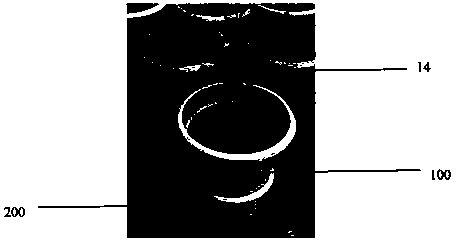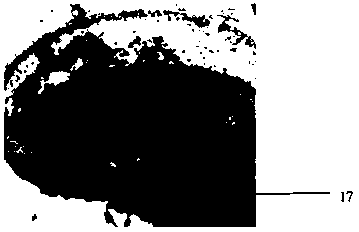Method for simply researching root aphids
An aphid and root technology, which is applied in the field of devices for researching agricultural pests, can solve the problems of destroying the living environment of the research subject, failing to complete data collection, and experimenting with errors in research data, and achieves strong operability, comfortable and reliable parasitic environment, and easy observation. Effect
- Summary
- Abstract
- Description
- Claims
- Application Information
AI Technical Summary
Problems solved by technology
Method used
Image
Examples
Embodiment 1
[0030] Example 1: Cultivation method of Aphid spp. indica (potting method-simple cupping method)
[0031] The Indian aphid is a kind of aphid that harms the root system of apples. It is mainly distributed in Zhaotong City, Yunnan Province. In the cultivation of apple trees in Zhaotong City, seedlings of crabapple seedlings are used as rootstocks for grafting. After survival, the grafted seedlings are used for colonization. The root of the apple tree is actually the root system of the seedlings of crabapple, and the Indian aphid is parasitic on this part. Therefore the present invention selects crabapple seedlings as the host plant, and the crabapple seedlings of different seedling stages can be bought in Zhaoyang District, and different seedling ages can be selected according to research needs.
[0032] Plant the crabapple seedlings on a large-diameter flowerpot (14.5cm in diameter, 11.5cm in height) (the first container), and make a small round hole with a diameter of about 1...
Embodiment 2
[0036] In this implementation example, both the first container and the second container are treated as transparent ( image 3), and other conditions are the same as those in the first implementation example. By this implementation example, the statistics of growth habit and physiological phenomenon data of aphids can also be carried out with a transparent container, relative to the implementation example, the transparent container can directly observe, without the need of each time as in the implementation example 1 All observations require the first container to be removed. Such experiments break with the common belief that root aphids can only be reared in dark conditions to be in line with their natural attributes. It is further illustrated by the following implementation examples that it is more convenient to use a transparent container for raising, and also obtain normal physiological data.
Embodiment 3
[0037] Embodiment 3: Determination of developmental duration and occurrence generation
[0038] The potted plants inoculated with aphids in implementation 2 were placed in an artificial climate box (Guangdong Medical Instrument Factory, RHL-250-GS, RH55-70%, light 12h), and the development history of Schizosporum indica was carried out. period of experiments, and calculated its developmental starting point temperature, effective cumulative temperature and annual generation generation. The experiment was set at 4 different temperatures, with 20-30 replicates (pots) per treatment, and 1 head per pot. The artificial inoculation method is adopted, that is, the 4th instar aphid or adult aphid is lightly inoculated on the roots of crabapple seedlings with a small wolf hair brush, and then re-soiled. Observe and record the state of each insect every day.
[0039] Some physiological indexes of aphids recorded at different temperatures were calculated according to the following metho...
PUM
 Login to View More
Login to View More Abstract
Description
Claims
Application Information
 Login to View More
Login to View More - R&D
- Intellectual Property
- Life Sciences
- Materials
- Tech Scout
- Unparalleled Data Quality
- Higher Quality Content
- 60% Fewer Hallucinations
Browse by: Latest US Patents, China's latest patents, Technical Efficacy Thesaurus, Application Domain, Technology Topic, Popular Technical Reports.
© 2025 PatSnap. All rights reserved.Legal|Privacy policy|Modern Slavery Act Transparency Statement|Sitemap|About US| Contact US: help@patsnap.com



